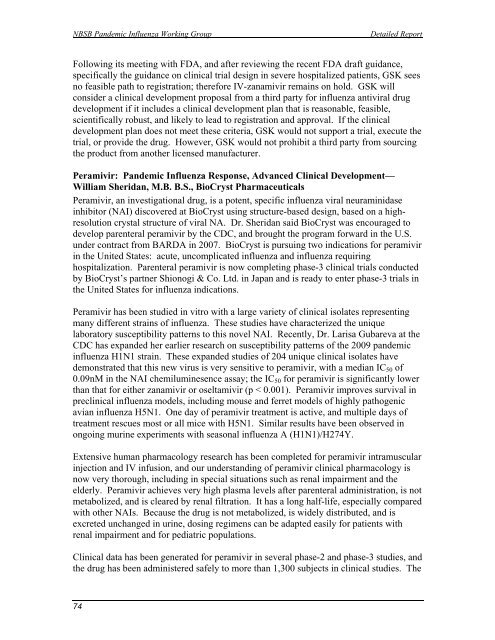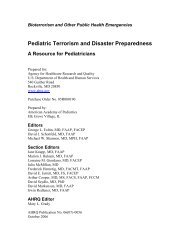H1N1 COUNTERMEASURES STRATEGY AND ... - PHE Home
H1N1 COUNTERMEASURES STRATEGY AND ... - PHE Home
H1N1 COUNTERMEASURES STRATEGY AND ... - PHE Home
You also want an ePaper? Increase the reach of your titles
YUMPU automatically turns print PDFs into web optimized ePapers that Google loves.
NBSB Pandemic Influenza Working Group<br />
Detailed Report<br />
Following its meeting with FDA, and after reviewing the recent FDA draft guidance,<br />
specifically the guidance on clinical trial design in severe hospitalized patients, GSK sees<br />
no feasible path to registration; therefore IV-zanamivir remains on hold. GSK will<br />
consider a clinical development proposal from a third party for influenza antiviral drug<br />
development if it includes a clinical development plan that is reasonable, feasible,<br />
scientifically robust, and likely to lead to registration and approval. If the clinical<br />
development plan does not meet these criteria, GSK would not support a trial, execute the<br />
trial, or provide the drug. However, GSK would not prohibit a third party from sourcing<br />
the product from another licensed manufacturer.<br />
Peramivir: Pandemic Influenza Response, Advanced Clinical Development—<br />
William Sheridan, M.B. B.S., BioCryst Pharmaceuticals<br />
Peramivir, an investigational drug, is a potent, specific influenza viral neuraminidase<br />
inhibitor (NAI) discovered at BioCryst using structure-based design, based on a highresolution<br />
crystal structure of viral NA. Dr. Sheridan said BioCryst was encouraged to<br />
develop parenteral peramivir by the CDC, and brought the program forward in the U.S.<br />
under contract from BARDA in 2007. BioCryst is pursuing two indications for peramivir<br />
in the United States: acute, uncomplicated influenza and influenza requiring<br />
hospitalization. Parenteral peramivir is now completing phase-3 clinical trials conducted<br />
by BioCryst’s partner Shionogi & Co. Ltd. in Japan and is ready to enter phase-3 trials in<br />
the United States for influenza indications.<br />
Peramivir has been studied in vitro with a large variety of clinical isolates representing<br />
many different strains of influenza. These studies have characterized the unique<br />
laboratory susceptibility patterns to this novel NAI. Recently, Dr. Larisa Gubareva at the<br />
CDC has expanded her earlier research on susceptibility patterns of the 2009 pandemic<br />
influenza <strong>H1N1</strong> strain. These expanded studies of 204 unique clinical isolates have<br />
demonstrated that this new virus is very sensitive to peramivir, with a median IC 50 of<br />
0.09nM in the NAI chemiluminesence assay; the IC 50 for peramivir is significantly lower<br />
than that for either zanamivir or oseltamivir (p < 0.001). Peramivir improves survival in<br />
preclinical influenza models, including mouse and ferret models of highly pathogenic<br />
avian influenza H5N1. One day of peramivir treatment is active, and multiple days of<br />
treatment rescues most or all mice with H5N1. Similar results have been observed in<br />
ongoing murine experiments with seasonal influenza A (<strong>H1N1</strong>)/H274Y.<br />
Extensive human pharmacology research has been completed for peramivir intramuscular<br />
injection and IV infusion, and our understanding of peramivir clinical pharmacology is<br />
now very thorough, including in special situations such as renal impairment and the<br />
elderly. Peramivir achieves very high plasma levels after parenteral administration, is not<br />
metabolized, and is cleared by renal filtration. It has a long half-life, especially compared<br />
with other NAIs. Because the drug is not metabolized, is widely distributed, and is<br />
excreted unchanged in urine, dosing regimens can be adapted easily for patients with<br />
renal impairment and for pediatric populations.<br />
Clinical data has been generated for peramivir in several phase-2 and phase-3 studies, and<br />
the drug has been administered safely to more than 1,300 subjects in clinical studies. The<br />
74
















